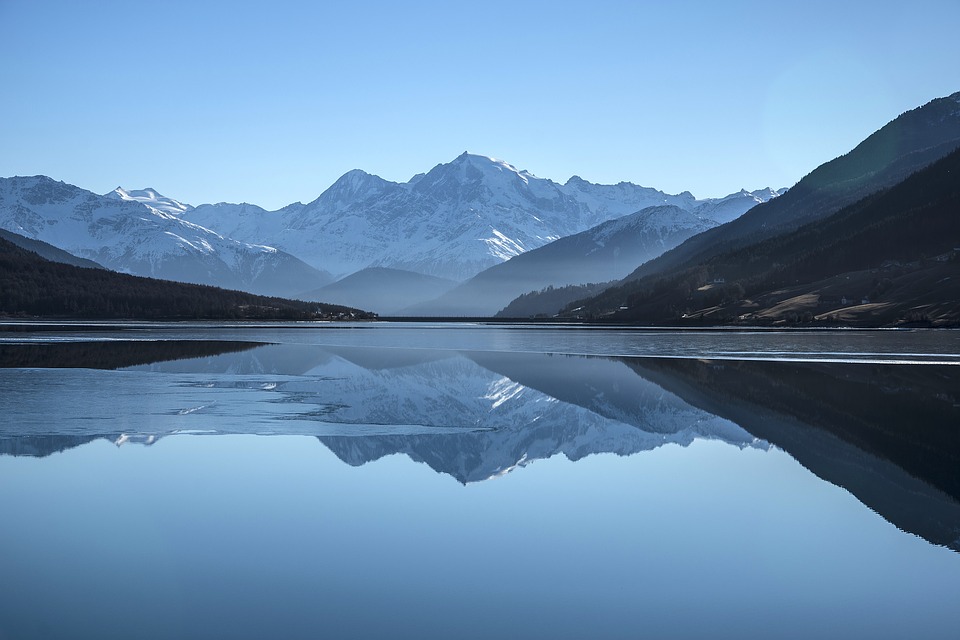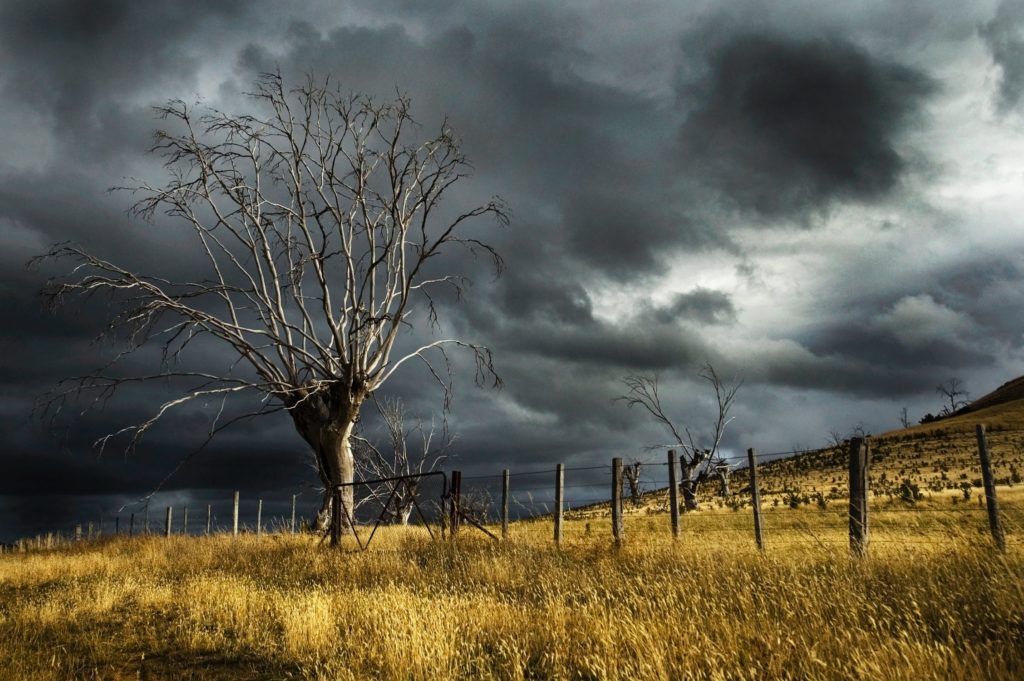Atmospheric effect is something that is not talked about much in photography and it is something that adds a lot of character and interest to photos, especially landscapes. Not many photographers are knowledgeable about atmospheric perspective, which is also called aerial perspective.
Knowing the broad elements of aerial perspective gives us an extra tool that we can use to compose more interesting photos and alter the atmosphere in our photos and this has been used for a very long time in eastern and western art. I thought it would be worthwhile to take a look at this effect and the various ways a landscape photographer can use it to get better images.

Understanding Image Planes to Understand Atmospheric Perspective
More often, when talking about perspectives, linear perspective is what comes to mind. Linear perspective is when lines are photographed, usually in architectural photography and converging lines are used to show depth in the image and linear perspective is one of the most common perspectives used in photography.
Then there is one point perspective, where there is one vanishing point in the frame. One point perspective is found in scenes where there are converging parallel lines that that seem to vanish at a distance. Mostly these lines that are formed by roads, railway tracks, etc, seem to vanish on the horizon line.
Before we go onto the concept of aerial perspective, it’s important to do a quick review of the concept of image planes in landscape photography.
Broadly speaking (and there are a million exceptions), in landscape photography, a scene will present three image planes – the foreground, the middle ground and the background.
Now, obviously this is very broad and generalist to the point of being useless (not every landscape image has all three), but it does provide us with the vocabulary to understand aerial perspective which can actually be quite useful in taking better landscape shots.
With image planes in mind, let’s move on…

What is Aerial Perspective? What is Atmospheric Perspective?
They are the same thing!
Aerial perspective, sometimes known as “atmospheric perspective” is the visual phenomenon in a landscape by which the foreground is dark-toned and more detailed, the middle ground is mid-toned and less detailed, and the background has a lighter tone and the least detail.
In general, atmospheric perspective refers to how colours and their details fade in the distance with less clarity and this helps to show or create a sense of depth mostly in landscape images. This change is an effect created by the atmosphere on the colours and details of things that we see at a distance, that is, distant objects. As the distance between the object and the viewer increases, the contrast decreases between the object and the background and also the details on the object as well decreases. Closer objects look clearer with more details, contrast, clarity and saturation.
(That explanation kind of makes it obvious why it is also sometimes called atmospheric perspective.)
For a technical explanation of why this happens, you might want to read about Rayleigh Scattering, but it’s not strictly necessary for our purposes.
When a landscape image has these elements in that particular way, it reinforces the viewer’s notion of what a landscape is. To quote John Hedgecoe, “we find them comforting.”
The aerial perspective effect is especially distinct in layered landscapes like that below where the layers are formed by elements at different distances.

Notice how the nearer objects display more detail, darker tone and vibrancy. Distant landscape features in the middle plane display less detail and middle tone. The background (the sky) has the lightest tones and smallest contrast or detail of all of the picture planes. It is an atmospheric effect that is apparent when you’re looking at most landscape scenes (though not all).
| Image Plane | Effect |
| Foreground | Detailed, dark |
| Middle Distance | Less detailed, mid-tones |
| Background / Far Distance | Little detail, light |
Note: The term aerial perspective and atmospheric perspective will be used interchangeably in this article.
How to Use Atmospheric Perspective for Better Landscape Photos
As with many things in photography – rules, guidelines, generalisations, and even natural effects, things like aerial perspective offer us an opportunity to use our knowledge to create compelling images.
How so?
Let’s explore.
One obvious way to use this information is to break the natural aerial perspective of a scene. If people are expecting to see a landscape photograph with a darker and more detailed foreground leading to a lighter and less detailed background, then your job as a photographer becomes trying to figure out ways to interrupt that pattern.
Alternatively, you can embrace the pattern as done in layered images. Either way, doing it deliberately tends to result in better photographs.
Let’s jump into some of the ways to break the perspective of traditional landscape photographs.
Shoot a Reflection Photo
The image below is a classic landscape reflection shot, but images like this tend to grab people’s attention because they break the natural order that we’re used to. Notice how the foreground now becomes as light as the background in tone. When the close-up area doesn’t do what our brains expect, we are immediately drawn into the image.

Look for Unusual Cloud Light
Another way to alter aerial perspective can happen with unusual lighting. We’re talking about times in the weather when you have a well lit foreground with dark clouds. Take a look at this example.

Chase Foreground Mist
Another way in which aerial perspective can be altered for more compelling images is to find foreground mist. Again, this shifts the dark tones and stronger detail that we normally expect from a foreground and can make the foreground as light as the background in some cases.

Digging Down into Breaking Atmospheric Perspective
Now, if we’re going to go into detail about how to generate more compelling images from your knowledge of atmospheric perspective, then let’s break it down to the image planes and see what we can come up with.
Foreground
In aerial perspective, with all things being equal, we would expect the foreground to be darker and more detailed than the rest of the scene. Anything that breaks this pattern, if used skillfully, can help to a more compelling landscape image with a spectacular atmosphere.
Above we mentioned mist, light and reflections as ways to break this pattern in your foreground. These are great starting points, but don’t be constrained. The ability to change things up is limited to your imagination. Elements such as snow, flowers, grass, sand, water or colour can all be used to shake up the foundations of aerial perspective in your shots.

Middle Distance
To my mind, middle ground can be a little tougher to alter in landscapes than foreground (unless your seriously plan your vantage point for shooting), but they are a long way from impossible.
With aerial perspective, the middle ground will have slightly less detail and slighter lighter tones than your foreground, but with some planning, it doesn’t have to be that way.
An obvious way to get around that is to include elements of detail in the middle ground – landmarks or elements that stand out. Buildings, trees, animals etc. These elements will also impact the overall atmosphere in your image, so choose wisely!

Background
With atmospheric perspective, we would expect the background or sky to be the lightest in tones and the lowest in details.
So how do we change that up?
An obvious way is to shoot storm clouds which are usually dark and often a lot more detailed than their white counterparts. They also enhance the ominous atmosphere if that's your goal! People find storm photos compelling partly for those reasons. Clouds, in general, when they differ from the standard white fluffy type can be used for compelling far distance shots, so think of color (such as that in the golden hour) or shape – things that can differentiate your skies from what people are expecting.
Layering (as in the top photo) is another way to emphasise that far distance. Layered shots are always popular when done well.
Leading lines are also a great way to draw the viewer’s eye towards the background of the image.

A Summary Of Some Important Things To Know About Atmospheric Perspective
Atmospheric perspective is the effect one sees and captures in their photographs when farther away objects look faded with less contrast and also the colours become less saturated. Continuing from the discussions above, these important things define atmospheric perspective.
- Because of atmospheric perspective, with increasing distance between the object and the viewer and object and background, the contrast between the object and the background decreases. Distant objects or the more distant objects appear less contrasty. This makes it difficult for the fine details to be visible, making it look faded or less detailed. When the same object is viewed at a closer distance, more details become visible with more clarity.
- Distance affects the scene making it look layered. This illusion of depth effect helps to add depth and visual appeal to the image. A great and common example of this effect is atmospheric shot of distant mountains. There will be a huge contrast between the brightest and darkest areas.
- If the light is strong and the foreground is illuminated by strong or harsh light, the atmospheric effect will decrease with increase in intensity of light.
- Depending on the direction of light falling on the scene, the brightness may increase with distance. The foreground will appear darker compared to the objects that are in the middle ground and background.
- Color saturation of distant objects will decrease compared to the objects closer to the viewer.
- Atmosphere affects the colours in the scene. The colours may become monochrome depending on the time of the day, the atmospheric conditions and direction of light. During the day time, when scattering occurs, the short wavelength blue light is scattered the most (while other wavelengths also get scattered up to some extent), the sky appears blue and the distant objects appear blue as well. This makes the appearance of objects in the scene more monochromatic.
- On a clear day, the atmospheric perspective effect can be less compared to the other days, but is still evident.
- Depending on the atmospheric conditions, the atmospheric perspective is even visible during the night time.

Final Thoughts
Aerial perspective is one of those effects that you never really think about until you start to have a reason. But when you know a little of it, suddenly, you start down the track of figuring out how you can use that knowledge to create more interesting landscape photographs with enchanting atmosphere.
Hopefully this set of ideas has given you some things to think about in terms of how to challenge the traditional aerial perspective shots and break up that effect to produce images that are more compelling and create a stronger reaction in your audience.
Further Landscape Photography Tutorials
If you love landscape photography then don't forget to take a look at our wonderful resource page on Landscape Photography Tutorials – we think it is great that you can get all these resources in one place and we hope it helps you to become the best landscape photographer you can be.
Further Learning
If you want to elevate your landscape photography then check out Kent DuFault's The Complete Landscape Photography Guide.
It is a fantastic guide packed with illustrations that give you the visuals to help you grasp the concepts of great landscape photography. There are also assignments that will help you put your learning into practice.







1 Comment
Really good reading , thanks very much.